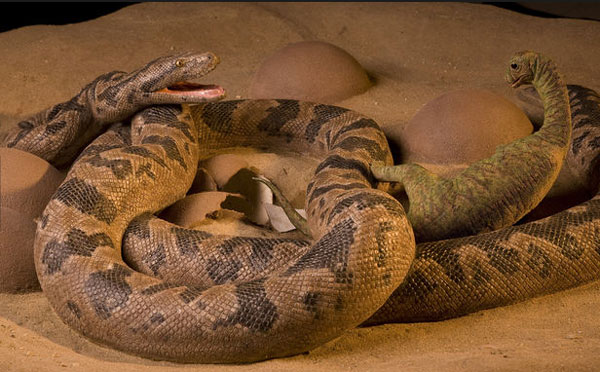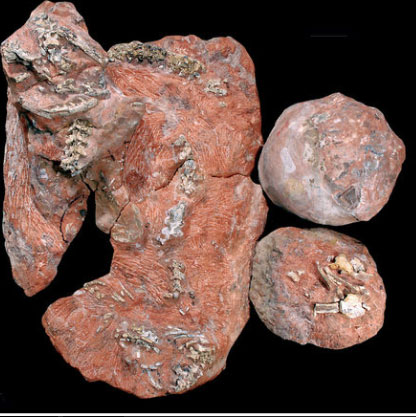The fossil shows a snake in the midst of preying on a titanosaur before sediment covers the nest.
The University of Michigan Museum of Natural History will open an exhibit showcasing a 67 million-year-old fossil of a snake in a dinosaur nest, in the middle of preying on a baby dinosaur. The first day of the exhibit is Saturday, February 15 at 4 p.m. at the UM Rackham Amphitheater, 915 E. Washington St. in Ann Arbor.

Photo by Ximena Erickson, U-M Museum of Paleontology
Life-size recreation of the scene by Chicago artist Tyler Keillor.
University of Michigan Paleontologist Dr. Jeffrey A. Wilson, and the man who found the fossil in India more than 30 years ago, Indian paleontologist Dr. Dhananjay Mohabey of the Geological Survey of India, will discuss the discovery that scientists initially thought was just a dinosaur nest. Scientists believe that the 19.6-inch hatchling dinosaur that was encased in sedmiment along with the snake was a titanosaur, a sauropod which is a group of long-necked dinosaurs that reach 62 to 82 feet in height when fully grown.

Photo by Jeffrey A. Wilson & Bonnie Miljour, U-M Museum of Paleontology
The original fossil was found in India in 1981 by Dr. Dhananjay Mohabey.
Dr. Jeffrey A. Wilson examined the fossil in 2001 and noticed that there was a snake in the nest. In 2004, the fossil was sent to the University of Michigan where it was cleaned. Scientists then made a research cast of the original prior to it being sent back to India. The snake in the fossil was given the scientific name Sanajeh indicus, which translates to "ancient gape from India." Dr. Wilson then commissioned a life-size recreation of the scene by Chicago artist Tyler Keillor. The sculpture, seen in the photo above, was then presented to the Indian government.
The fossil is interesting because snake fossils are hard to find due to the fragile nature of the skeletons, and it shows animal behavior during that era. According to the UM Museum of Natural History, only a handful of snake fossils from the dinosaur era have been found with skull and vertebrate intact, and Sanajeh indicus is the only fossil of a well preserved snake found on the Indian subcontinent.


